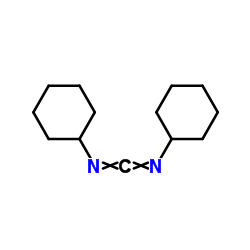Dicyclohexylcarbodiimide

Dicyclohexylcarbodiimide structure
|
Common Name | Dicyclohexylcarbodiimide | ||
|---|---|---|---|---|
| CAS Number | 538-75-0 | Molecular Weight | 206.33 | |
| Density | 1.325 | Boiling Point | 122-124 ºC (6 torr) | |
| Molecular Formula | C13H22N2 | Melting Point | 34-35 °C(lit.) | |
| MSDS | Chinese USA | Flash Point | 87 ºC | |
| Symbol |



GHS05, GHS07, GHS08 |
Signal Word | Danger | |
|
Amelioration of radiation-induced oral cavity mucositis and distant bone marrow suppression in fanconi anemia Fancd2-/- (FVB/N) mice by intraoral GS-nitroxide JP4-039.
Radiat. Res. 182(1) , 35-49, (2014) The altered DNA damage response pathway in patients with Fanconi anemia (FA) may increase the toxicity of clinical radiotherapy. We quantitated oral cavity mucositis in irradiated Fanconi anemia Fancd2(-/-) mice, comparing this to Fancd2(+/-) and Fancd2(+/+) ... |
|
|
Mediated Electron Transfer at Vertically Aligned Single-Walled Carbon Nanotube Electrodes During Detection of DNA Hybridization.
Nanoscale Res. Lett. 10 , 978, (2015) Vertically aligned single-walled carbon nanotube (VASWCNT) assemblies are generated on cysteamine and 2-mercaptoethanol (2-ME)-functionalized gold surfaces through amide bond formation between carboxylic groups generated at the end of acid-shortened single-wa... |
|
|
Controlled Endolysosomal Release of Agents by pH-responsive Polymer Blend Particles.
Pharm. Res. 32 , 2280-91, (2015) A key step of delivering extracellular agents to its intracellular target is to escape from endosomal/lysosomal compartments, while minimizing the release of digestive enzymes that may compromise cellular functions. In this study, we examined the intracellula... |
|
|
Thermophilic Coenzyme B12-Dependent Acyl Coenzyme A (CoA) Mutase from Kyrpidia tusciae DSM 2912 Preferentially Catalyzes Isomerization of (R)-3-Hydroxybutyryl-CoA and 2-Hydroxyisobutyryl-CoA.
Appl. Environ. Microbiol. 81 , 4564-72, (2015) The recent discovery of a coenzyme B12-dependent acyl-coenzyme A (acyl-CoA) mutase isomerizing 3-hydroxybutyryl- and 2-hydroxyisobutyryl-CoA in the mesophilic bacterium Aquincola tertiaricarbonis L108 (N. Yaneva, J. Schuster, F. Schäfer, V. Lede, D. Przybylsk... |
|
|
A family of cationic polyamides for in vitro and in vivo gene transfection.
Acta Biomater. 22 , 120-30, (2015) The purpose of this study is to develop biodegradable cationic polyamides for non-viral gene delivery and elucidate their structural effects on gene transfection activity. To this end, a group of novel cationic polyamides were synthesized by polycondensation ... |
|
|
An Oligonucleotide Transfection Vector Based on HSA and PDMAEMA Conjugation: Effect of Polymer Molecular Weight on Cell Proliferation and on Multicellular Tumor Spheroids.
Macromol. Biosci. 15 , 965-78, (2015) A novel gene transfection vector was fabricated based on the conjugation of human serum albumin (HSA) and maleimide end functionalized poly[(N,N-dimethylamino) ethyl methacrylate] (PDMAEMA). The bioconjugation was achieved in a site-specific manner to yield w... |
|
|
Synthesis of folate- pegylated polyester nanoparticles encapsulating ixabepilone for targeting folate receptor overexpressing breast cancer cells.
J. Mater. Sci. Mater. Med. 26 , 275, (2015) The aim of this study was the preparation of novel polyester nanoparticles based on folic acid (FA)-functionalized poly(ethylene glycol)-poly(propylene succinate) (PEG-PPSu) copolymer and loaded with the new anticancer drug ixabepilone (IXA). These nanopartic... |
|
|
Diels-Alder hydrogels with enhanced stability: First step toward controlled release of bevacizumab.
Eur. J. Pharm. Biopharm. 96 , 217-25, (2015) Eight-armed PEG was functionalized with furyl and maleimide groups (8armPEG20k-Fur and 8armPEG20k-Mal); degradable hydrogels were obtained by cross-linking via Diels-Alder chemistry. To increase the stability to degradation, the macromonomers were modified by... |
|
|
A Combination of Targeted Sunitinib Liposomes and Targeted Vinorelbine Liposomes for Treating Invasive Breast Cancer.
J. Biomed. Nanotechnol. 11 , 1568-82, (2015) Regular chemotherapy cannot eradicate invasive breast cancer cells and the residual cancer cells will form vasculogenic mimicry (VM) channels under hypoxic conditions to provide nutrients for cancer masses prior to angiogenesis. This phenomenon is a major rea... |
|
|
Mitochondria apoptosis pathway synergistically activated by hierarchical targeted nanoparticles co-delivering siRNA and lonidamine.
Biomaterials 61 , 178-89, (2015) The mitochondria-mediated apoptosis pathway is an effective option for cancer therapy due to the presence of cell-suicide weapons in mitochondria. However, anti-apoptotic proteins that are over-expressed in the mitochondria of many malignant tumors, such as B... |